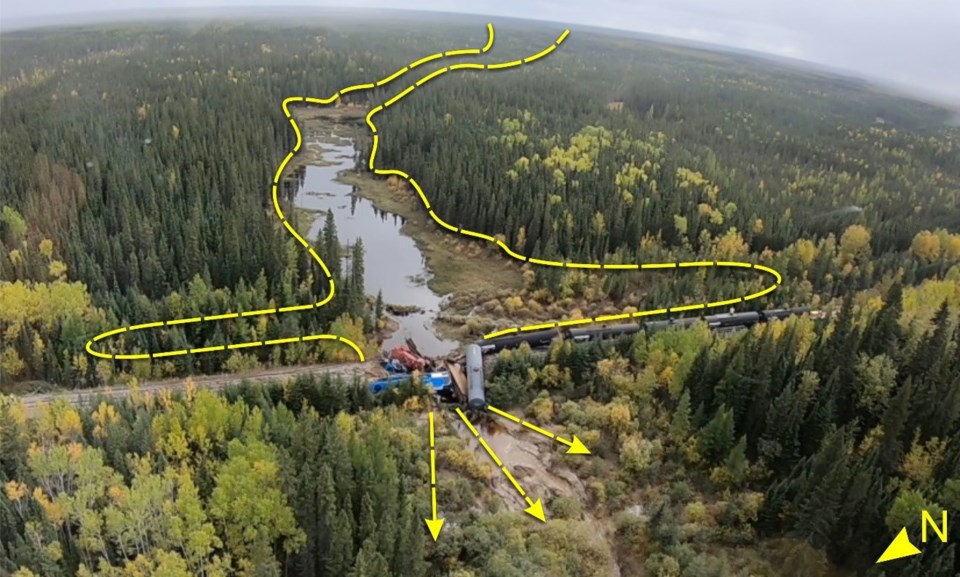It took more than seven hours for emergency medical personnel to arrive on the scene of a Hudson Bay Railway freight train derailment near Ponton in September 2018 because they needed to ensure the scene was safe because the train was transporting dangerous goods, a Transportation Safety Board of Canada (TSB) investigation report released April 23 says.
A conductor who was one of two crew members trapped in one of the train’s locomotives died a little more than an hour after Thompson fire & Emergency Services (TFES) personnel arrived at the scene, about 15 kilometres southwest of Highway 6 south of Ponton. The other crew member, the locomotive engineer, was extricated from the wreckage shortly afterwards and taken by helicopter to Thompson General Hospital in critical condition.
The train was travelling about 40 kilometres per hour when it hit a 50-foot section of track where the rail bed had washed out. Because the rails and ties were still in place, the engineer did not apply the emergency brake before the derailment occurred because he could not see that the rail bed had washed away.
The section of track where the three locomotives and four other cars derailed had been inspected two days before the Sept. 15, 2018 accident. At that time, the rail bed was still intact.
The cause of the washout was the breach of beaver dams upstream and east of the rail line, which increased the flow and volume of water accumulating just east of and immediately adjacent to the site where the accident occurred. This increased hydraulic pressure on the raised sand-based fill under the track, saturating it and washing it away along with two wood box culverts through which water normally flowed. The force of the water carried timbers from the box culverts, which had been identified for replacement, as far as 1,000 feet downstream of their original location, the TSB said. Precipitation in the summer of 2018 was about 60 per cent higher than the historical average.
The derailment occurred around 4:30 p.m. and was spotted by a helicopter pilot picking up surveyors in the area about an hour later. Because the accident occurred in an area where train crews were not required by HBR policy to check in at regular intervals, the accident might not have been noticed until the train failed to show up at Wabowden around 6 p.m. if not for the helicopter.
Previous railway owner OmniTrax had engaged in a beaver dam removal project along the railways a few years before the accident, but abandoned it in 2017 when flooding north of Gillam led to the company shutting down rail service on the line. The railway and the Port of Churchill had been purchased by the Arctic Gateway Group less than a month before the accident occurred. The TSB also said that track inspectors and supervisors employed by HBR had not received any geotechnical training since OmniTrax purchased the rail line in 1997, nor prior to that, and were not fully aware of the potential consequences of uneven ponding against the rail bed and how this could affect soil stability.
The location of the accident was slowed emergency responders from arriving at the scene. An attempt to travel to the site using all-terrain vehicles failed when they sustained flat tires and they were eventually transported to the site on an HBR hi-rail truck that initially travelled in the wrong direction, towards Wabowden, before turning around and heading to the accident site west of Highway 6 south of Ponton. Equipment used in the extrication of the crew members who were pinned in the locomotive cab hd limited effectiveness when cutting the heavy-gauge steel used in locomotive construction.
The TSB also said that HBR’s emergency response plan did not set forth any processes or procedures for responding to a train derailment, particularly one that involved dangerous goods and employee injuries/fatalities, occurring in a remote location.
Since the accident, HBR has inspected all culverts on all its railway subdivisions and initiated a more comprehensive beaver control program. It has also updated its emergency response plan and modified its communications policy to require crews to check in with rail traffic controllers every hour when travelling in remote areas.




